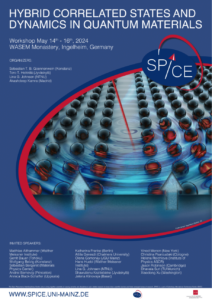 The SPICE workshop "Hybrid Correlated States and Dynamics in Quantum Materials" will be held from May 14th to 16th, 2024 at the historic WASEM winery, Ingelheim.
The SPICE workshop "Hybrid Correlated States and Dynamics in Quantum Materials" will be held from May 14th to 16th, 2024 at the historic WASEM winery, Ingelheim.
The workshop focusses on correlated states of electrons, that give rise to quantum matter, such as ordered magnets, spin liquids, superconductors, and topological materials. The exciting phenomena hosted and technological applications promised by these states of matter have further inspired the scientific community to engineer hybrids where different ingredients for correlations are provided by separate materials coupled together. Thus, such low-dimensional hybrid nanostructures have enabled engineering novel states of matter with intriguing physics, often not admitted by any single platform.
With the recent developments, theoretical and experimental, time reversal symmetry breaking via magnetism has emerged as a powerful tool to engineer novel unconventional superconducting states and phenomena such as nonreciprocity. At the same time, engineering of the superconducting condensate to bear a net spin employing magnet/superconductor hybrids has been demonstrated. This has opened prospects for superconducting spintronics devices enabling dissipationless spin torques and logic. Further, spin fluctuations appear to play a fundamental role in a large fraction of unconventional and two-dimensional superconductors including the recently discovered states in moiré materials. Therefore, these three seemingly disjoint fields are intricately relying on knowledge from each other and can best be tackled with an overview of all three. Providing this overview and a common discussion platform is the main goal of this workshop.
The workshop shall bring together experts and young researchers from three different communities: (i) Magnetism and Spintronics, (ii) Superconductivity and Strongly Correlated Electrons, and (iii) Low-dimensional nanostructures. The purview includes coherent and incoherent magnetization dynamics in conjunction with the various spintronics effects that allow its manipulation and detection. A key topic will be the recently discovered nonreciprocal effects in magnets e.g., chiral magnons, as well as superconductors, e.g., the superconducting diode effect. Recent discoveries regarding two-dimensional materials, multi-orbital superconductivity, Ising superconductors, topological superconductivity and quantum sensors coupled to magnets will also be central to the workshop portfolio. Employing fluctuations of currents (e.g, flow of spin or vortices) to probe the quantum nature of transport will form an exciting topic of discussion across communities. Finally, the case of spin fluctuations mediated superconductivity, that is believed to underlie a wide range of unconventional superconductors can best be discussed with the three communities present at the workshop.




